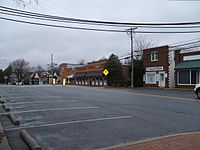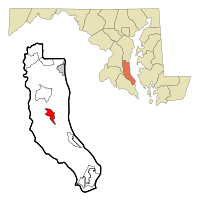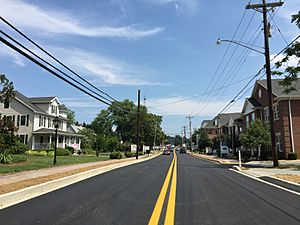Prince Frederick, Maryland facts for kids
Quick facts for kids
Prince Frederick, Maryland
|
|
|---|---|

Downtown Prince Frederick
|
|

Location of Prince Frederick, Maryland
|
|
| Country | United States |
| State | Maryland |
| County | Calvert |
| Founded | 1722 |
| Named for | Frederick, Prince of Wales |
| Area | |
| • Total | 3.67 sq mi (9.50 km2) |
| • Land | 3.66 sq mi (9.49 km2) |
| • Water | 0.00 sq mi (0.01 km2) |
| Elevation | 138 ft (42 m) |
| Population
(2020)
|
|
| • Total | 3,226 |
| • Density | 880.94/sq mi (340.11/km2) |
| Time zone | UTC−5 (Eastern (EST)) |
| • Summer (DST) | UTC−4 (EDT) |
| ZIP code |
20678
|
| Area code(s) | 410 |
| FIPS code | 24-63950 |
| GNIS feature ID | 0591073 |
Prince Frederick is a community in Calvert County, Maryland, United States. It's called a 'census-designated place' (CDP) because it's a special area defined for counting people. Prince Frederick is also the main town, or 'county seat,' of Calvert County. In 2020, about 3,226 people lived here. This was an increase from 2,538 people in 2010.
Contents
Geography and Climate
Prince Frederick is located right in the middle of Calvert County. You can find its exact spot using these coordinates: 38°32′55″N 76°35′19″W / 38.54861°N 76.58861°W.
The area covers about 9.5 square kilometers (3.67 square miles). Most of this land is dry, with only a tiny bit of water.
Weather in Prince Frederick
The weather here has hot and humid summers. Winters are usually mild to cool. Prince Frederick has a humid subtropical climate. This means it gets plenty of rain all year, and the temperatures are generally warm.
Community Life
Prince Frederick is a lively place with many services and activities. It's the main center for shopping and businesses in Calvert County.
Local Services and Schools
The town has its own volunteer fire department and rescue squad. Calvert Memorial Hospital serves the community's health needs.
Students attend Calvert High School. Their sports teams are called the Cavaliers. There is also a public middle school and a public elementary school. The College of Southern Maryland has a campus here, which opened in 2005.
Places of Worship
Many churches and religious groups are in Prince Frederick. These include St. John Vianney Catholic Church, St. Paul's Episcopal Church, and Trinity United Methodist Church. You can also find the First Baptist Church of Calvert County, Full Gospel Assembly of God, and the Southern Maryland Islamic Center.
Shopping and Entertainment
Prince Frederick is a hub for shopping. It has several large shopping centers. You can find many restaurants, both chain and local. There are also three hotels and the only movie theater in Calvert County.
Work and Business
Many people who live in Prince Frederick travel to jobs in the larger Baltimore-Washington Metropolitan Area. However, some companies are based right in town. An industrial park on the west side of Prince Frederick has attracted many businesses. One example is Recorded Books, L.L.C., which publishes audiobooks.
News and Library
Two local newspapers serve Calvert County: The Calvert Recorder and The Calvert Gazette. The main branch of the Calvert Library moved to a new, larger building in 2006. This building is named after Russell Costley, who strongly supported the library for many years.
Parks and Recreation
The Edward T. Hall Aquatics Center opened in 2010. It has a large indoor pool, a diving area, and smaller pools for therapy and fun. Hallowing Point Park is a county park west of Prince Frederick. It offers tennis courts, fields for baseball, softball, and soccer, plus hiking trails.
You can also visit the Battle Creek Cypress Swamp, a nature preserve. The Arthur Storer Planetarium is located at Calvert High School. Every fall, the Calvert County Fair is held just outside Prince Frederick.
History of Prince Frederick
Prince Frederick has been the main town of Calvert County since 1722. Officials chose a piece of land called "Williams' Old Field" for the new county courthouse. The first courthouse was finished in 1732. The town was likely named after Frederick, Prince of Wales, who was the son of King George II.
Fires and Rebuilding
During the War of 1812, British forces attacked the area. In June 1814, they burned down the town of Prince Frederick.
In 1882, Prince Frederick burned down a second time. A huge fire destroyed almost the entire town, including the courthouse. A new courthouse was built in the same spot. It is still the center of Calvert County's government today.
Modern Development
In the 1960s, a famous African-American architect named Albert Irvin Cassell planned a large summer resort for African-Americans called Chesapeake Heights on the Bay. Some roads and homes were built, but the project stopped when Cassell passed away in 1969.
In 1984, Calvert County's government named Prince Frederick one of seven "town centers." This meant that even though it wasn't officially a city, special rules would help new buildings fit in. This plan aimed to use existing services and prevent messy growth.
Linden, a historic place, was added to the National Register of Historic Places in 2000.
On April 28, 2002, a very strong tornado passed just south of Prince Frederick. It caused damage and one person died. This same tornado also hit the town of La Plata nearby.
Transportation Routes
Solomons Island Road is the main road that runs north and south through Prince Frederick. It is part of two Maryland routes: Maryland Route 2 and Maryland Route 4. Route 2 goes from Baltimore to Solomons. Route 4 comes from Washington, D.C. and continues past Solomons. These two routes meet north of Prince Frederick.
In 2009, a part of Route 2–4 in Prince Frederick was made wider to have three lanes in each direction.
Other important roads include Maryland Route 231 (Hallowing Point Road), which goes west into Charles County. Maryland Route 402 (Dares Beach Road) leads east to Dares Beach. Maryland Route 765 is Prince Frederick's Main Street, giving access to the courthouse.
In the mid-1990s, new loop roads were planned to help local traffic avoid the main Route 2-4. Prince Frederick Boulevard is one of these new roads. Chesapeake Boulevard also opened in 2010. More roads are planned for the future.
Notable People
Many interesting people have connections to Prince Frederick:
- Louis L. Goldstein: He was the Comptroller of the Maryland Treasury for many years. He was born in Prince Frederick in 1913.
- Earl F. Hance: He served as a Calvert County Commissioner and was the Secretary of the Maryland Department of Agriculture.
- Augustus Rhodes Sollers: He was a congressman.
- Roger Brooke Taney: He was the Chief Justice of the U.S. Supreme Court. He was born and grew up on a farm near Prince Frederick.
The best-selling author Tom Clancy used to run an insurance business in Prince Frederick before he became a writer. He also owned a home near Prince Frederick until he passed away in 2013.
See also
 In Spanish: Prince Frederick (Maryland) para niños
In Spanish: Prince Frederick (Maryland) para niños



